Mid-Infrared Gas Sensing Using a Photonic Bandgap Fiber as a Gas Cell
Gas sensing in the mid-infrared region is examined.

A femtosecond optical parametric oscillator (OPO) has been used to characterize the transmission of a number of different all-silica photonic bandgap (PBG) fibers specifically developed for gas sensing in the mid-infrared region. One of these fibers was chosen for its optimum transmission band (bandgap) overlap with methane fundamental absorption spectrum around 3.2 μm. Fourier transform–infrared (FT-IR) spectroscopy of methane has been demonstrated using the air-core of the PBG fiber as a gas cell and the OPO as a light source for concentrations down to 1000 ppm. A comparison with theoretical predicted values is presented alongside the measurements. An evaluation of the signal noise suggests that a measurement resolution better than 100 ppm concentration is achievable using this system.
Gas sensing is becoming increasingly important for process control, environmental studies, and safety monitoring. Typically, it is necessary to determine the concentration and composition of a gas sample. Gas species selectivity, which can be an issue for many different types of gas sensors, can be addressed in the case of optical sensing by the well-proven technique of absorption spectroscopy. The use of optical fibers in spectroscopy offers a number of potential advantages over conventional gas cell configurations: they can easily provide remote access to hazardous locations, and distributed sensing topologies become feasible. Moreover, due to their high mechanical flexibility and their small dimension, they present a potential for miniaturization of the system, which is an important advantage to access confined sites. Unlike optical fibers, typical gas cells can be relatively large and not suited to remote measurement or use in small spaces. Furthermore, the size of the cell determines the minimum quantity of gas required, which can be a limiting factor if only small gas samples are available.
Examples of optical fiber gas sensor systems already exist, but these are limited due to potential contamination of the sensing area (for example, D-shaped fibers [1], in which the cladding thickness is reduced greatly on one side of the fiber, to allow interaction with the light in the core), or the fiber is used only to access conventional gas cells and thus is not directly involved in the sensing aspect (2). Moreover, optical fiber-based systems demonstrated to date typically operate below 2 μm due to the large silica absorption in the mid-infrared (mid-IR) region. Below 2 μm, gas absorption features are weak overtone resonances, thereby requiring long interaction lengths and highly sensitive techniques to make useful gas concentration measurements. In the 3–6 μm region, it is possible to probe stronger fundamental resonances; therefore, fiber delivery in this wavelength band could potentially enable more sensitive detection, contingent upon the availability of suitable fiber-compatible mid-IR sources. The recent development of new light sources operating in this region, such as lead-salt lasers (3), quantum cascade lasers (4), or difference frequency generation lasers (5,6), means that there is potential for enhanced sensitivity for mid-IR spectroscopy.
Photonic Bandgap Fibers
Recently, silica photonic bandgap (PBG) fibers, similar to the one illustrated in Figure 1, have attracted particular interest for their ability to guide light in an air-core unlike the solid core of other microstructured fiber and conventional fiber designs. Unlike conventional silica fibers, these PBG fibers rely upon the so-called bandgap effect (7) for guidance rather than total internal reflection. This means that they can transmit only over a narrow range of wavelengths, often referred to as the fiber's bandgap, typically 100–200 nm wide in the IR. PBG fibers can guide over 98% of the light outside the fused silica in the hollow core and air holes around the core (8), and thus are ideally suited to gas sensing. The low fraction of light guided in the glass means that the material absorption plays a smaller role in overall fiber attenuation characteristics, and therefore, these fibers have the potential to transmit light in the mid-IR region beyond the usual silica transmission window (below 2 μm). We have previously demonstrated an all-silica PBG fiber for mid-IR transmission and its potential for methane gas sensing (9,10). In this article, we present a number of PBG fibers designed and fabricated for operation around 3.2 μm, thereby making them suitable for methane sensing. Mid-IR absorption measurements for methane are also presented, in which we have used one of these fibers as a gas cell and a femtosecond optical parametric oscillator (OPO) as a light source suitable for use with a Fourier-transform spectrometer.
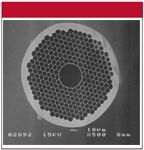
Figure 1: Scanning electron micrograph of a PBG fiber.
OPO Light Source
Highly sensitive gas absorption spectroscopy requires a light source that combines a broad wavelength range, good spatial beam quality, and appropriate output power. Commonly used thermal sources allow easy access to a wide range of spectral regions but cause severe problems when it comes to tight focusing and guiding in an optical setup and offer limited optical power. Laser sources overcome this problem, but it is only relatively recently that laser sources in the 3-μm region have become available (3–6). Where a laser exists at a suitable wavelength, it is usually necessary for it to be either tunable or broadband to record absorption spectra across an appropriate spectral region to allow for species identification and intensity normalization. For wavelength regions in which direct laser emission is not available, parametric oscillation in a nonlinear crystal can be used to produce light beams with spectra centered on wavelengths longer than the laser source itself. If both the pump laser and the parametric conversion process are broadband, then parametric oscillation can be used to realize a broadband tunable laser in any wavelength range lying within the transmission window of the nonlinear crystal used.
In our experiments, we used 100-fs pulses from a Ti:sapphire laser as the pump and a periodically poled lithium niobate (PPLN) crystal as the nonlinear medium for converting 800-nm light into tunable mid-IR light covering the 2.7–3.4 μm region. These wavelengths correspond to the nonresonant idler output of the oscillator, but a complementary near-IR output (the signal) also exists from 1–1.2 μm, which is resonant in the OPO cavity. The oscillator emission range is shown in Figure 2, in which different spectra were obtained by slight adjustments of the OPO cavity length; 2.5 μm of cavity length adjustment was sufficient to tune the center wavelength of the idler pulses by several hundreds of nanometers.
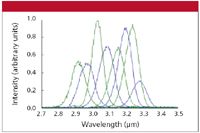
Figure 2: Tuning abilities of the OPO used in the experiment. Alternate spectra are shown in different colors for clarity.
Transmission Measurements of Photonic Bandgap Fibers
To identify the PBG with the transmission profile that best matched the methane absorption band, we measured the transmission spectra of a number of HC-PBG fiber samples. The experimental arrangement for measuring the spectra is shown in Figure 3. The OPO idler beam was sent through a cavity mirror to an FT-IR spectrometer consisting of a scanning Michelson interferometer. Light leaving the interferometer was coupled into an 80-cm-long PBG fiber using a 25-mm focal length ZnSe lens. The average power after the lens was ~500 μW, but it was still below the saturation level of the detector, which was a PbSe photodiode. The detector could be positioned to measure the idler with or without the fiber, and a Ge filter was placed between the interferometer and the fiber-coupling lens to remove wavelengths other than those of interest. The interferometer scanning mirror was mounted on a linear actuator running at a frequency of 0.5 Hz over a usable range of 3.6 mm, corresponding to a postprocessed wavelength resolution of about 3 nm in the measured spectrum. The spectra were calculated by a Fourier transform of the interferogram acquired in a single period scan of the interferometer mirror. To produce a calibration interferogram and hence compensate for any nonlinearity in the optical path scan, a He-Ne laser also was directed into the interferometer along a parallel path to the main beam.
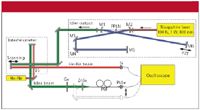
Figure 3: Experimental setup for PBG fibers transmission and methane sensing. Intensity (arbitrary units)
Several fibers were characterized. They were fabricated using a stack-and-draw technique (11): silica capillary tubes were stacked in an array with a triangular lattice configuration to manufacture a preform (Figure 4). A total of 19 capillaries were omitted at the center of the stack to form the core. The whole stack was then jacketed with a silica cladding and drawn down to the final fiber dimensions. The optical properties of the PBG fibers can be tailored mainly by changing the air-filling fraction (fraction of air in the fiber cross-section). The fibers had a core diameter of ~40 μm and a pitch, which is the distance between the center of two neighboring cladding holes, varying between 6 and 7 μm due to natural variations in the drawing process (in this case, the variation was introduced deliberately by varying the different pressures applied in the core and cladding during the fabrication process).

Figure 4: Preform stack of silica capillaries with 19 tubes removed from the center in order to form the core.
For transmission measurements, the idler spectrum was measured sequentially directly from the oscillator and then after being transmitted through a fiber. The spectral bandwidth of the OPO light was about 100 nm, so to cover the entire PBG transmission band, it was necessary to measure several interferograms by tuning the OPO to several different central wavelengths covering most of the region of interest. Starting from one end of the idler spectrum, the He-Ne signal and idler with and without the fiber were recorded. The idler was then tuned in steps of 80 nm and spectral measurements were repeated so that a total of four interferograms were recorded for each tuning position to obtain spectra for both the reference idler and the idler via the fiber after Fourier transforming. Therefore, the fiber transmission spectrum over the 3.2–3.4 μm region could be calculated.
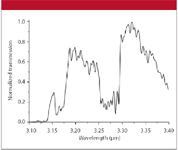
Figure 5: Transmission of the optimum PBG fiber chosen for methane sensing.
All four fibers tested revealed a bandgap providing guidance of light at wavelengths above 3 μm. However, for different reasons, such as the position of the bandgap in terms of wavelength, the optical source wavelength limitation, or the presence of strong spectral oscillations in the transmission bandgap, only one fiber was chosen for methane measurements. As can be seen in Figure 5, the spectrum of this fiber displays a relatively broad transmission window around 3.32 μm, where the strongest methane spectral features can be observed. This fiber was thus considered to be the optimum one for methane detection. Figure 6 shows the overlap between the methane spectral lines (from the HITRAN database [12]) and the bandgap of the selected fiber.
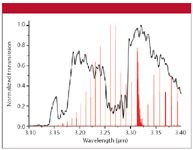
Figure 6: Spectral overlap between methane fundamental absorption lines (in red â from Hitran) and fiber 2 bandgap (in black).
Methane Sensing
To determine the filling dynamics of the methane–nitrogen gas mix within the fiber core, a pressure sensor was attached to one end of an 80-cm-long PBG fiber. At the other end of the fiber, a vacuum pump, a methane–nitrogen supply, and another pressure sensor were attached. Pressures at both sensors were monitored simultaneously, showing that the entire fiber was evacuated and then filled with a methane–nitrogen gas mix at 2 bar. This filling process was completed in <10 min, and this time was used as a typical filling time for our system.
To evaluate the system for spectroscopic gas detection, both ends of the fiber were mounted inside connectors that allowed light to be coupled into and out of the fiber through CaF2 windows while providing a means to fill the fiber core with a precisely controlled mixture of methane and nitrogen. The absorption spectrum of methane was measured over the 3.19–3.36 μm range. Results are shown in Figure 7a, and the calculations of absorption derived from the HITRAN database taking into account the pressure, temperature, fiber length, and the system spectral resolution are presented in the same figure (dashed lines). Measurements were repeated for 1%, 0.5%, and 0.1% methane concentrations and are shown in Figures 7b, 7c, and 7d, respectively. The main absorption band (3.32 μm) is still clearly visible (30% absorption) for a volume concentration of 0.1% (1000 ppm).
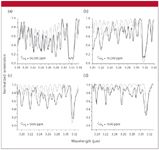
Figure 7: Measured (solid lines) and theoretical (dashed lines) absorption lines of methane for different concentrations.
Results and Discussion
The measured absorption lines show a good general agreement with those predicted from the HITRAN database. In particular, the principal feature, which is the broadest absorption band, between 3.31 and 3.32 μm, is located at the expected wavelength. Discrepancies between theoretical and experimental results might be explained by the small signal-to-noise ratio at the edge of the OPO signal and data-processing error during the concatenation required due to the limited bandwidth of the measured idler. Indeed, as different OPO pulses over the spectral region of interest were used, concatenating the data was necessary, which could introduce some error. However, we note that measurements over such a wide range of wavelengths are not indispensable. In some gas sensing schemes, one absorption line and an appropriate reference measurement (for example a gas-free reference) might be sufficient.
In our experiments, the OPO instability also made measurements difficult. A slight change in temperature can cause a cavity tuning, resulting in wavelength and power shifts. The comparison between the methane-free and the methane-full fiber output signal required care to ensure that there was no significant change in the OPO spectrum between signal and reference measurements. This is not a significant issue for high gas concentrations (>0.1%), in which the absorption was still strong enough. However, it is a limiting factor for lower concentrations because the intensity of the absorption lines decreases significantly for concentrations below 0.05%. Improved source stability and simultaneous measurement of the light spectrum before and after the fiber would bring substantial improvements.
Optimizing the tradeoff between the requirements for maximum gas interaction length with the increasing fiber losses associated with longer fibers might increase the system performance further.
Conclusion
We report the characterization and potential sensing application of fused-silica PBG fibers for use in the mid-IR region. These fibers, in which the majority of the light is confined in a bandgap-guiding air-core, provide excellent interaction between the guided light and the gas in the core. Furthermore, as the light is guided in a gas-filled core, the glass material absorption is less significant and we are able to operate at longer wavelengths (up to 3.45 μm), which is impossible using conventional silica glass fibers. For the fibers described here, there exists a good spectral overlap, with methane fundamental absorption lines indicating an interesting potential for gas sensing. Using one of these fibers as a gas cell, we have demonstrated methane sensing for concentrations down to 0.1% by FT-IR with a femtosecond OPO as a mid-IR optical source. The system shows that PBG fibers have a great potential for mid-IR gas sensing.
References
(1) F.A. Muhammad, H.S. Al-Raweshidy, and J.M. Senior, Sensor Actuat. B: Chem. 40, 59–63 (1997).
(2) G. Stewart, C. Tandy, D. Moodie, M.A. Morante, and F. Dong, Sensor Actuat. B: Chem. 51, 227–232 (1998).
(3) Secdilas IR series of PbSe laser diodes, Laser Components (UK) Ltd., Goldlay House, Chelmsford, Essex, UK. http://www.lasercomponents.com
(4) J. Devenson, D. Barate, O. Cathabard, R. Teissier, and A.N. Baranov, Appl. Phys. Lett. 89(19), 191115-1–191115-3 (2006).
(5) C. Erny, K. Moutzouris, J. Biegert, D. Kühlke, F. Adler, A. Leitenstorfer, and U. Keller, Opt. Lett. 32(9), 1138–1140 (2007).
(6) IRIS1000 DFG-based mid-infrared laser system, Novawave Technologies, Redwood City, California. http://www.novawavetech.com
(7) E. Yablonovitch, Phys. Rev. Lett. 58(20), 2059–2062 (1987).
(8) P.J. Roberts, F. Couny, H. Sabert, B.J. Mangan, D.P. Williams, L. Farr, M.W. Mason, A. Tomlinson, T.A. Birks, J.C. Knight, and P. St. J. Russell, Opt. Express 13(1), 236–244 (2005).
(9) N. Gayraud, L.W. Kornaszewski, J.M. Stone, J.C. Knight, D.T. Reid, D.P. Hand, and W.N. MacPherson, Appl. Opt. 47(9), 1269–1277 (2008).
(10) L. Kornaszewski, N. Gayraud, J.M. Stone, W.N. MacPherson, A.K. George, J.C. Knight, D.P. Hand, and D.T. Reid, Opt. Express 15(18), 11219–11224 (2007).
(11) P. St. J. Russel, Science 299, 358–362 (2003).
(12) L.S. Rothman, D. Jacquemart, A. Barbe, D. Chris Benner, M. Birk, L.R. Brown, M.R. Carleer, C. Chackerian Jr., K. Chance, L.H. Coudert, V. Dana, V.M. Devi, J.-M. Flaud, R.R. Gamache, A. Goldman, J.-M. Hartmann, K.W. Jucks, A.G. Maki, J.-Y. Mandin, S.T. Massie, J. Orphal, A. Perrin, C.P. Rinsland, M.A.H. Smith, J. Tennyson, R.N. Tolchenov, R. A. Toth, J. Vander Auwera, P. Varanasi, and G. Wagner, J. Quant. Spectrosc. Radiat. Transf. 96, 139–204 (2005).
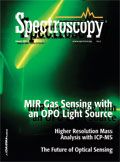
Newsletter
Get essential updates on the latest spectroscopy technologies, regulatory standards, and best practices—subscribe today to Spectroscopy.
Integrating Spectroscopy with Machine Learning to Differentiate Seed Varieties
July 15th 2025Researchers at the University of Belgrade have demonstrated that combining Raman and FT-IR spectroscopy with machine learning algorithms offers a highly accurate, non-destructive method for identifying seed varieties in lettuce, paprika, and tomato.